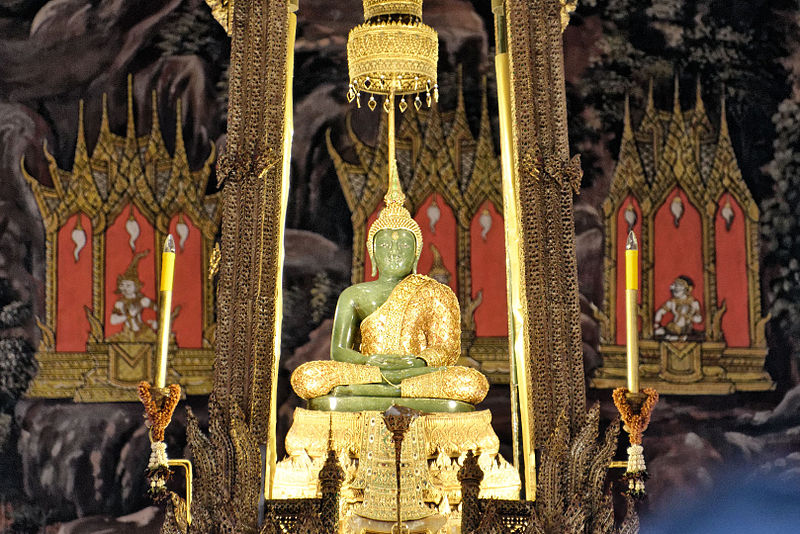The Emerald Buddha is the most sacred object in Thailand. It is the nation’s palladium, meaning that keeping it safe also protects Thailand. The Kings of Thailand traditionally swear oaths of loyalty before it. Politicians caught in scandals swear their innocence to the Emerald Buddha to rehabilitate their public images.
Legends say the Emerald Buddha was created in what is now the Bihar state of India in 43 BCE by a sage named Nagasena, with the help of the Hindu deities Vishnu and Indra. (For the record, Nagasena is a possibly historical figure named an early Buddhist scripture called the Milindapañhā, and per that scripture he would have lived in about 150 BCE.) Other legends claim the Buddha figure was carried to many places in southeast Asia over the centuries.
The statue is not, in fact, emerald. The seated Buddha was carved from a single piece of grey-green jasper. This is a gemstone found in many parts of the world, but it’s suspected this particular stone may have originated in India. The statue is 26 inches (66 centimeters) in height and 19 inches (48.3 centimeters) wide at the lap. The small figure sits on a pedestal nearly thirty feet, or nine meters, high so that it towers over the people in the ordination hall where it is housed. Three times a year, the Emerald Buddha’s gold and diamond vestments are changed to fit the season in an elaborate ceremony.
Legends aside, the documented history of the figure begins in the 15th century. And that’s where we’ll begin also.
The Emerald Buddha Is Discovered
According to one widely accepted chronicle, the Emerald Buddha was discovered inside a stupa — a type of small shrine that serves as a reliquary — in what is now northern Thailand in 1434. A lightning strike had opened the stupa, and a monk saw what appeared to be a stucco Buddha figure inside. In a few days the stucco began to flake off, revealing the grey-green jasper beneath.
It’s claimed the mysterious figure was first kept in a temple in today’s Lampang, Thailand. Legend says that a king ordered the figure to be brought to his temple, but the elephants employed to transport the figure insisted on going to Lampang, instead. So there it was. It was moved to Chiang Mai, Thailand –Thailand was then called Siam — in 1468. In 1552 a king of Laos took it to his temple, and the statue spent a couple of centuries in Vientiane, Laos. In 1778 a Siamese general named Taksin captured Vientiane and took the statue back to Siam/Thailand. Since 1784 it has been installed in its present location in the Wat Phra Kaew temple in Bangkok.
Some art historians have proposed, based on its style, that the figure was carved in northern Thailand in the 15th century. Other art historians have argued its origins were more likely Indian or Sri Lankan. In brief, nobody knows where it came from or how old it really is, or who might have covered it in stucco and hidden it in a stupa.
The Temple of the Emerald Buddha
Phra Phutthayotfa Chulalok (1737–1809), who went by a number of other names, was the founder of the Chakri dynasty. The dynasty still reigns in Thailand, although Thailand has been a constitutional monarchy with a parliament and prime minster since 1932. Phutthayotfa Chulalok established Bangkok as his capital in 1782 and built the Wat Phra Kaew temple on the grounds of his palace. Wat Phra Kaew is an especially gorgeous temple that is a must-see for anyone visiting Bangkok.
It was Phutthayotfa Chulalok, a.k.a. Rama I, who began the tradition of dressing the Emerald Buddha in gold vestments. To this day, three times a year the reigning monarch officiates at the ceremony in which the seasonal vestments are changed. (Note also that Phutthayotfa Chulalok was the grandfather of Mongkuk of The King and I.)

